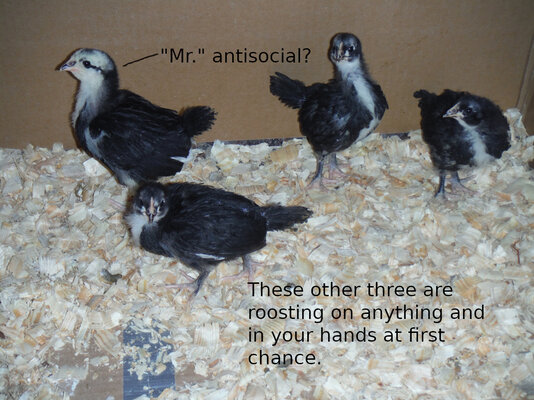YourChickHasAPastyButt
Chirping
So... we are new to chickens this year, but I have noticed something very telling about all the black australorp roos we ended up with vs. other chick breeds that have all turned out to be pullets, and now three of the four australorp chicks we have now. All the chicks that did turn out to be pullets have had two behavior traits from just a few weeks on.
1. Coming to your hand and wanting to be held. The ones that have turned out to be cockerels always kept a distance from your hands.
2. Wanting to jump up on items and roost.
Out of the batch of four australorp chicks we have now, I'm already fairly certain we have three pullets this time and another cockerel, just based off this behavior. Time will tell.
1. Coming to your hand and wanting to be held. The ones that have turned out to be cockerels always kept a distance from your hands.
2. Wanting to jump up on items and roost.
Out of the batch of four australorp chicks we have now, I'm already fairly certain we have three pullets this time and another cockerel, just based off this behavior. Time will tell.
Last edited:






 . Most agile breed we've had so far. They are up and down everything left and right. Little balls of energy. The one "Brahma" we were sold turned out to be a Golden Comet (left side of roost). She is the friendliest one in the flock. She runs to my daughter to be held all the time. We thought she was frizzled, and her feathers stayed frizzled until 3 days being moved outside. Then she shed the frizzled feathers and looks like a normal Golden Comet now.
. Most agile breed we've had so far. They are up and down everything left and right. Little balls of energy. The one "Brahma" we were sold turned out to be a Golden Comet (left side of roost). She is the friendliest one in the flock. She runs to my daughter to be held all the time. We thought she was frizzled, and her feathers stayed frizzled until 3 days being moved outside. Then she shed the frizzled feathers and looks like a normal Golden Comet now.  Glad though, because I was worried about her handling the cold with her feathers like that. They are all hitting a growth spurt since we put them in the coop/run. Introducing new birds to a flock turned out to be extremely stressful. I made an area below that roost I blocked off with 1" garden fencing and cut a whole just big enough for them to get through so they could retreat and see each other. After a week, they got along fine. They are really mean to newcomers for a spell.
Glad though, because I was worried about her handling the cold with her feathers like that. They are all hitting a growth spurt since we put them in the coop/run. Introducing new birds to a flock turned out to be extremely stressful. I made an area below that roost I blocked off with 1" garden fencing and cut a whole just big enough for them to get through so they could retreat and see each other. After a week, they got along fine. They are really mean to newcomers for a spell.